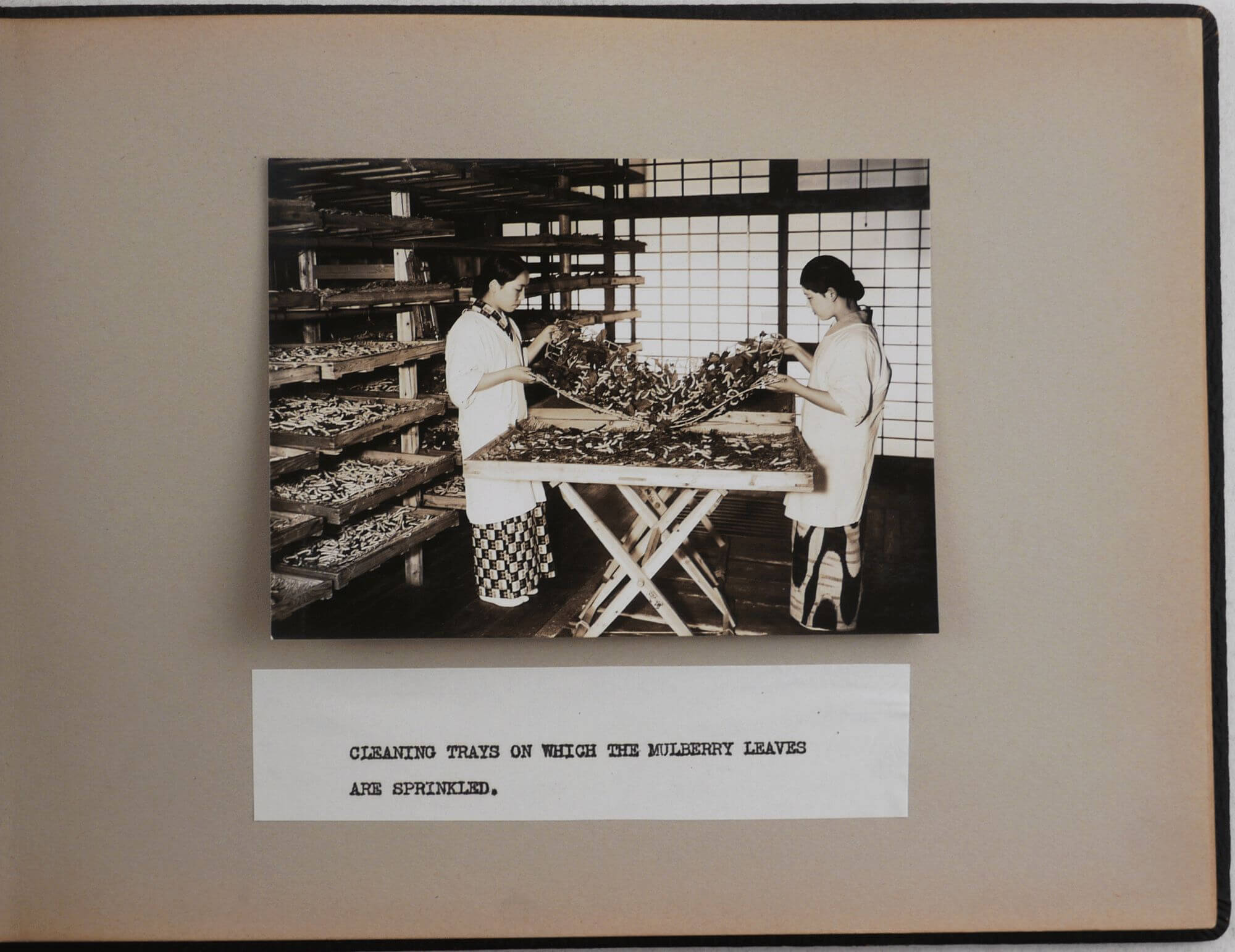


























#PC4
Ca. 1937
Oblong Folio album ca. 23,5x34 cm (9 ¼ x 13 ¼ in). 24 card stock leaves (6 blank at rear). With 33 mounted gelatin silver photos, from ca. 11,5x16 cm (4 ½ x 6 ¼ in) to ca. 10,5x14 cm (4 x 5 ½ in). All photos with captions in English, typewritten on paper labels, mounted under the images. The first leaf with a typewritten title in English, completed with a manuscript ink presentation inscription to Dr. Monroe. Period black patterned sheep album fastened with a string; gilt-lettered generic title “Photographs” on the front board; decorative endpapers. Binding very mildly rubbed on extremities, a couple of photos with mild silvering, but overall a very good album of strong interesting photos.
Historically significant visual source on the Japanese raw silk industry in the 1930s, when the country was the world’s leading producer of this luxury commodity. The album was presented by the Central Raw Silk Association of Japan (est. 1931) to a noted American educator and professor at Columbia University, Paul Monroe (1869-1947), most likely during his participation in the 7th World’s Education Conference, held in Tokyo on August 1-8, 1937. Monroe attended the conference as president of the World Federation of Education Associations, in which capacity he served in 1931-33 and 1935-43. The photos and accompanying captions provide a detailed overview of the production of raw silk in Japan in the 1930 and also show the “Industrial district of raw silk” in Okaya (Nagano prefecture), the buildings of Silk Conditioning Houses (quality control facilities) in Yokohama and Kobe, and the grounds of the Institute of Sericulture (most likely in Tokyo). Overall an important collection of original photographs of facilities and operations in the Japanese silk industry in the 1930s.
A list of captions (without the annotations): Cocoons; Microscopical inspection of silkworm eggs; Washing the eggs; The worms hatched out of the egg; Picking mulberry leaves; Feeding silkworms; Cleaning trays on which the mulberry leaves are sprinkled; Silkworms; Cutting the trees with the leaves; Silkworms; A full-grown silkworm (nearly actual size); Mounting; Two days after the mounting; Plucking Cocoons; Industrial district of raw silk; Drying cocoons; Boiling of Cocoons; Reeling; Re-reeling; Skein making; Book making; The conditioning house of Yokohama; The conditioning house of Kobe; Visual inspection (general finish); Visual inspection (inspection of skein); Conditioning test; Winding test; 450 meter skein test; Weighing the sample skein for sizing test; Cohesion test; Tenacity and elongation test; Seriplane test; The Institute of Sericulture, Dep. of Forestry & Agriculture.
“Unquestionably one of the giants in American educational scholarship, Paul Monroe <…> was a member of the faculty of Teachers College, Columbia University, and it was largely due to his efforts that the history of education became a great scholarly discipline cast in its broad social and philosophical setting <…>.” Monroe supervised the publication of the fundamental “Cyclopedia of Education” (New York, 1911-1913, 5 vols.), and greatly contributed to the development of public education in the United States, China, the Philippines, Puerto Rico, Iraq and Turkey (see more: Brickman, W., Cordasco, F. Paul Monroe’s Cyclopedia of Education// History of Education Quarterly, vol. 10, No. 3 (Autumn 1970), pp. 324-337).
“In 1853, the US Navy’s Commodore Perry arrived in Japan. This became a trigger for the beginning of trade with western countries. At that time, Japanese exports were minor and consisted mainly of raw silk and tea, of which silk represented more than 60% of the total. For about 80 years from the opening of Yokohama Port in 1859 until Japan’s entry into World War II in 1941, raw silk production increased in line with exports. In 1909 (Meiji era, 42nd year), Japan surpassed China in raw silk production and became the world’s No. 1 silk producer. The foreign currency obtained from exporting raw silk was used for the purchase of industrial commodities, including machinery from the West, which became the foundation for the modernization and industrialization of Japan” (Country Profile – Japan// International Sericultural Commission; https://inserco.org/en/japan).


































